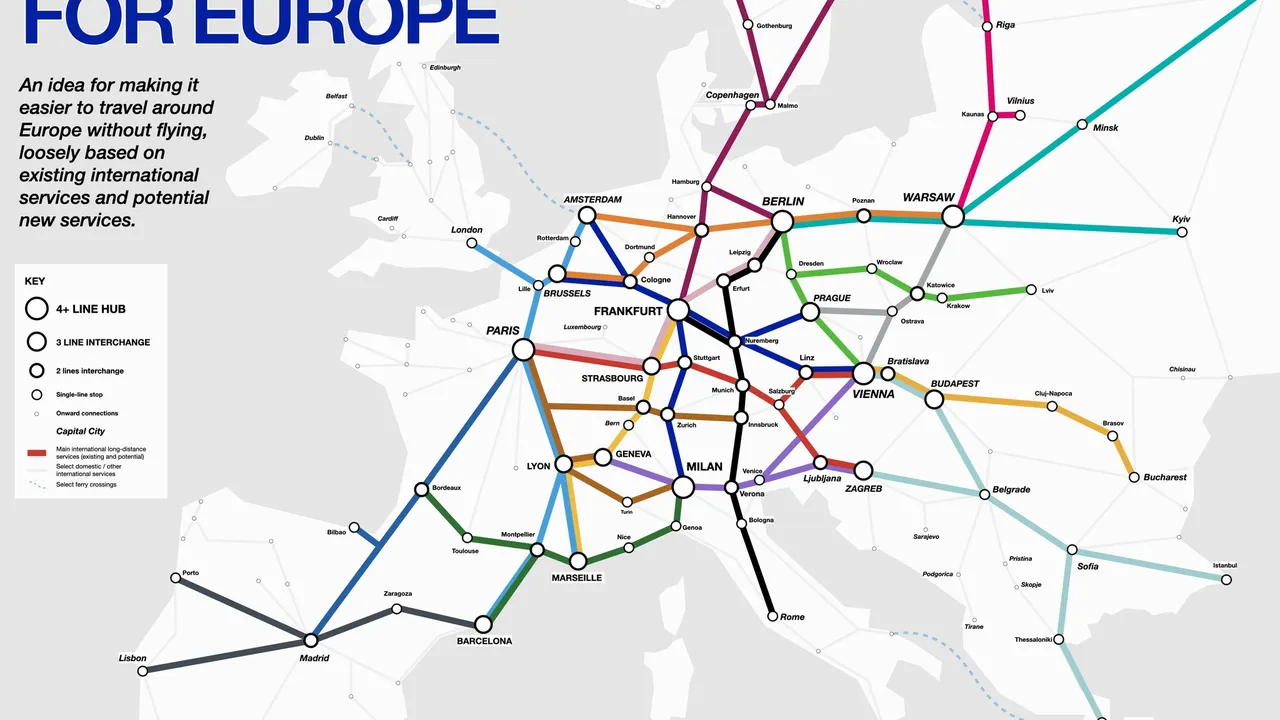Currency Exchange Tips for US Travelers in Europe
Sample meta description.

Understanding Exchange Rates for European Travel
Okay, so you're heading to Europe! Fantastic! But before you start picturing yourself sipping espresso in Rome or climbing the Eiffel Tower, let's talk about something a little less glamorous but super important: money. Specifically, currency exchange. Understanding exchange rates is crucial to avoid getting ripped off and to budget effectively for your trip. The exchange rate is simply the value of one currency in terms of another. For example, how many Euros (€) you can get for one US Dollar ($).
Exchange rates fluctuate constantly. They're affected by various factors like economic performance, political stability, and even global events. You can check current exchange rates on websites like Google Finance, XE.com, or directly through your bank or credit card company. Keep an eye on the rates in the weeks leading up to your trip to get a sense of the trends. This will help you decide when the best time to exchange your money might be. Don't expect to time the market perfectly, but being aware is always helpful.
Also, remember that the rate you see online isn't necessarily the rate you'll get when you actually exchange your money. Banks and exchange services add fees and commissions, which we'll talk about later.
Best Places to Exchange Currency for Europe
So, where should you actually get your Euros (or Swiss Francs, or British Pounds, or whatever currency you need)? You have a few options, each with its own pros and cons:
- Your Bank or Credit Union: This is often a good starting point. They usually offer competitive rates, especially if you're a long-time customer. Call ahead to check their rates and fees, and to make sure they have the currency you need in stock. They might need a few days to order it in.
- Online Currency Exchange Services: Companies like Travelex and Currency Exchange International (CXI) offer online ordering and often have physical locations where you can pick up your currency. Compare their rates and fees carefully. Sometimes, ordering online can get you a slightly better rate than exchanging in person.
- Airport Exchange Kiosks: Avoid these if at all possible! They almost always offer the worst exchange rates and charge exorbitant fees. They prey on travelers who are desperate and haven't planned ahead. Unless you're in a dire emergency, skip them.
- Currency Exchange Booths in Europe: Similar to airport kiosks, these often have unfavorable rates and high fees. Look for reputable banks or ATMs instead.
- ATMs in Europe: This is generally the best option for getting cash once you arrive in Europe. Use ATMs affiliated with major banks to minimize fees. Check with your bank before you leave to see if they have any partner banks in Europe that offer lower fees. Also, be aware of foreign transaction fees that your bank might charge.
Fees and Commissions: The Hidden Costs of Currency Exchange
This is where things can get tricky. It's not just about the exchange rate itself; you also need to factor in the fees and commissions that various exchange services charge. These fees can significantly eat into your travel budget if you're not careful.
Here's what to look out for:
- Commission Fees: This is a percentage of the amount you're exchanging. It can range from 1% to 5% or even higher.
- Transaction Fees: Some services charge a flat fee per transaction, regardless of the amount you're exchanging.
- Service Fees: This is a catch-all term for various other fees that might be tacked on. Always ask for a breakdown of all fees before you commit to an exchange.
- Hidden Fees: Be wary of exchange services that don't clearly disclose their fees upfront. Ask questions and read the fine print.
The best way to avoid excessive fees is to shop around and compare rates and fees from multiple providers. Don't be afraid to negotiate, especially if you're exchanging a large amount of money.
Credit Cards vs. Cash in Europe: Which is Better?
The age-old question! The answer is: it depends. Both credit cards and cash have their advantages and disadvantages.
Credit Cards:
- Pros: Convenient, secure (if you have fraud protection), often offer rewards points or cashback, good for larger purchases like hotels and rental cars.
- Cons: Foreign transaction fees (usually around 3%), not accepted everywhere, can be easy to overspend.
Cash:
- Pros: Accepted everywhere, helps you stick to your budget, good for smaller purchases like coffee, souvenirs, and public transportation.
- Cons: Can be lost or stolen, not ideal for large purchases, inconvenient to carry large amounts of it.
The ideal approach is to use a combination of both. Use your credit card for larger purchases and places that accept them, and use cash for smaller purchases and places that don't. Look for a credit card that doesn't charge foreign transaction fees. Many travel credit cards offer this perk, along with other benefits like travel insurance and airport lounge access.
Travel Credit Card Recommendations (with No Foreign Transaction Fees)
Okay, let's talk specifics. Here are a few travel credit cards that are popular among US travelers and don't charge foreign transaction fees:
- Chase Sapphire Preferred: This card offers valuable rewards points that can be redeemed for travel, dining, and other purchases. It also has a generous sign-up bonus and good travel insurance coverage. The annual fee is $95.
- Use Case: Ideal for travelers who want a versatile rewards card with good travel benefits. Use it for dining, travel, and everyday spending to maximize your points.
- Comparison: Compared to the Chase Sapphire Reserve (which has a higher annual fee), the Preferred offers a lower annual fee with still very good rewards. It's a great choice for those who don't travel *constantly* but still want travel perks.
- Price: $95 annual fee.
- Capital One Venture Rewards Credit Card: This card offers a simple rewards structure – you earn a flat rate on all purchases. It also has a generous sign-up bonus and no foreign transaction fees. The annual fee is $95.
- Use Case: Perfect for those who prefer a simple rewards structure and don't want to track different bonus categories. Use it for all your purchases and redeem your miles for travel.
- Comparison: Compared to the Chase Sapphire Preferred, the Venture Rewards offers a simpler rewards program but may not offer as many bonus categories.
- Price: $95 annual fee.
- Bank of America Travel Rewards Credit Card: This card is a good option for those who want a simple rewards card with no annual fee. You earn points on all purchases and can redeem them for travel.
- Use Case: A solid choice for budget-conscious travelers who want a no-annual-fee card with travel rewards.
- Comparison: Compared to the Chase Sapphire Preferred and Capital One Venture, this card offers fewer perks and a lower rewards rate, but it's a great option for those who want to avoid annual fees.
- Price: No annual fee.
Before applying for any credit card, be sure to check your credit score and compare the terms and conditions of different cards. Choose the card that best fits your spending habits and travel needs.
Debit Cards: A Less Desirable Option
While debit cards offer convenience, they often come with higher foreign transaction fees compared to credit cards. Additionally, they may not offer the same level of fraud protection. Using a debit card at an ATM in Europe can also result in hefty fees from both your bank and the ATM operator.
It's generally best to avoid using your debit card for purchases or ATM withdrawals in Europe. Stick to credit cards with no foreign transaction fees and ATMs affiliated with major banks.
Prepaid Travel Cards: Another Alternative
Prepaid travel cards are another option for managing your money in Europe. These cards are loaded with a specific amount of money before your trip and can be used like a debit card. However, they often come with various fees, such as activation fees, reload fees, and ATM withdrawal fees. Be sure to read the fine print carefully before using a prepaid travel card.
While prepaid travel cards can offer some convenience, they're generally not the most cost-effective option. Credit cards with no foreign transaction fees and ATMs affiliated with major banks are usually a better choice.
Using ATMs in Europe: Tips and Tricks
As mentioned earlier, ATMs are generally the best way to get cash once you arrive in Europe. Here are a few tips to help you minimize fees and maximize your convenience:
- Use ATMs Affiliated with Major Banks: These ATMs usually offer lower fees than independent ATMs. Look for ATMs from banks like BNP Paribas (France), Deutsche Bank (Germany), or Santander (Spain).
- Check with Your Bank for Partner Banks: Some banks have partnerships with banks in Europe that allow you to withdraw cash without paying foreign transaction fees.
- Decline Dynamic Currency Conversion (DCC): When withdrawing cash from an ATM, you may be asked if you want to be charged in your home currency (US Dollars). Decline this option! DCC usually comes with a very unfavorable exchange rate. Always choose to be charged in the local currency (Euros, Pounds, etc.).
- Withdraw Larger Amounts Less Frequently: This will help you minimize the number of transaction fees you pay. However, don't withdraw so much cash that you feel uncomfortable carrying it around.
- Be Aware of Your Surroundings: Use ATMs in well-lit and secure locations. Cover the keypad when entering your PIN.
Budgeting for Currency Exchange: How Much Should You Bring?
This is a tough question to answer, as it depends on your travel style, destination, and length of stay. However, here are a few general guidelines:
- Research Average Daily Expenses: Look up the average cost of food, transportation, and activities in the cities you plan to visit. Websites like Budget Your Trip and Numbeo can be helpful.
- Factor in Accommodation and Transportation Costs: These are usually the biggest expenses. If you've already booked your accommodation and transportation, you'll have a better idea of how much cash you'll need for other expenses.
- Consider Your Spending Habits: Are you a budget traveler who prefers to eat at local cafes and use public transportation, or do you prefer to dine at fancy restaurants and take taxis?
- Bring a Buffer: It's always a good idea to bring a little extra cash in case of emergencies or unexpected expenses.
As a general rule of thumb, it's a good idea to have enough cash to cover a few days' worth of expenses. You can always withdraw more cash from ATMs as needed.
Currency Exchange Apps: Managing Your Money on the Go
There are several currency exchange apps that can help you track exchange rates, convert currencies, and manage your money while you're traveling. Here are a few popular options:
- XE Currency Converter: This app offers real-time exchange rates and allows you to convert currencies quickly and easily.
- Currency Converter Plus: This app supports over 170 currencies and offers offline access to exchange rates.
- Revolut: This app allows you to exchange currencies at interbank rates and spend money in multiple currencies without paying foreign transaction fees. (Note: Revolut's terms and fees can change, so verify before relying on it).
These apps can be helpful for tracking your spending and ensuring that you're getting the best possible exchange rates.
Protecting Yourself from Scams
Unfortunately, scams related to currency exchange are not uncommon. Here are a few tips to help you protect yourself:
- Be Wary of Unsolicited Offers: Don't accept currency exchange offers from strangers on the street or in public places. These are often scams.
- Check the Exchange Rate Before You Commit: Make sure you understand the exchange rate and any fees before you agree to exchange your money.
- Count Your Money Carefully: Always count your money carefully after you receive it to make sure you've received the correct amount.
- Keep Your Money Secure: Store your cash in a safe place, such as a money belt or a hidden pocket.
- Report Suspicious Activity: If you suspect that you've been scammed, report it to the local authorities.
Final Thoughts on Currency Exchange for Europe
Navigating currency exchange can seem daunting, but with a little planning and preparation, you can avoid getting ripped off and manage your money effectively while traveling in Europe. Remember to shop around for the best exchange rates, be aware of fees, use a combination of credit cards and cash, and protect yourself from scams. Happy travels!
:max_bytes(150000):strip_icc()/277019-baked-pork-chops-with-cream-of-mushroom-soup-DDMFS-beauty-4x3-BG-7505-5762b731cf30447d9cbbbbbf387beafa.jpg)






